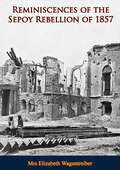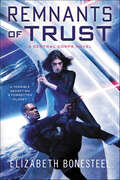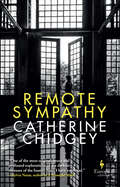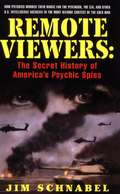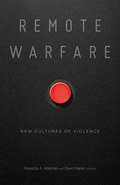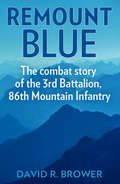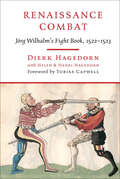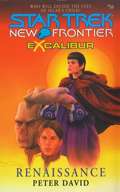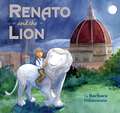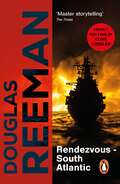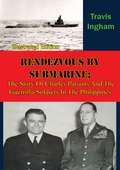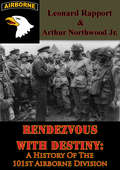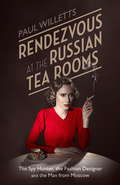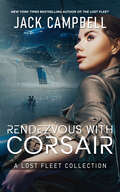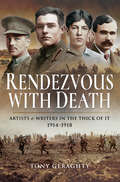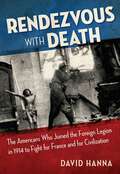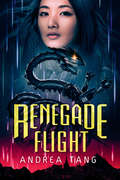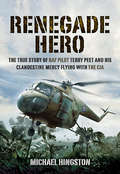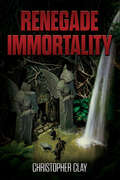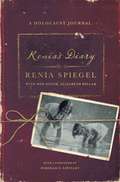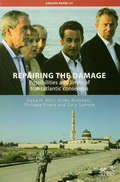- Table View
- List View
Reminiscences of the Sepoy Rebellion of 1857
by Mrs Elizabeth Wagentreiber“Elizabeth Wagentreiber was the youngest daughter of Colonel James Skinner of the famous cavalry regiment 'Skinner's Horse'. She had originally married a Captain Radclyffe Haldane, an officer of Skinner's Horse who was killed at the Battle of Chillianwallah during the Second Anglo-Sikh War. She subsequently married George Wagentreiber. And in the Spring of 1857 the couple were living in the civilian lines at Delhi when the Indian Mutiny broke out in the Bengal Army and reports arrived that the native cavalry was running amok in the city, slaughtering Europeans. Fearful for their lives the couple escaped with their children and the harrowing account of their time as fugitives makes compelling reading.”-Print ed.
Remnants of Trust: A Central Corps Novel
by Elizabeth BonesteelA young soldier finds herself caught in the crosshairs of a conspiracy in deep space in this novel by the author of The Cold Between and Arkhangelsk . . . Six weeks ago, Commander Elena Shaw and Captain Greg Foster were court-martialed for their role in an event Central Gov denies ever happened. Yet instead of a dishonorable discharge or time in a military prison, Shaw and Foster and are now back together on Galileo. As punishment, they’ve been assigned to patrol the nearly empty space of the Third Sector.But their mundane mission quickly turns treacherous when the Galileo picks up a distress call: Exeter, a sister ship, is under attack from raiders. A PSI generation ship—the same one that recently broke off negotiations with Foster—is also in the sector and joins in the desperate battle that leaves ninety-seven of Exeter’s crew dead.An investigation of the disaster points to sabotage. And Exeter is only the beginning. When the PSI ship and Galileo suffer their own “accidents,” it becomes clear that someone is willing to set off a war in the Third Sector to keep their secrets, and the clues point to the highest echelons of power . . . and deep into Shaw’s past.“Elena and Greg have a complicated dynamic of friendship and thwarted attraction . . . They rely on this bedrock when it seems they are surrounded by treachery and secret plots.” —Library Journal (starred review)“Surprising, convincing character development makes this series worth following.” —Publishers Weekly (starred review)
Remote Sympathy
by Catherine ChidgeyThis polyphonic novel of an S.S. officer, his ailing wife, and a concentration camp survivor “marks a vital turn in Holocaust literature” (Publishers Weekly, starred review).Being appointed administrator of the Buchenwald work camp is a major advancement for SS Sturmbannführer Dietrich Hahn. But as the prison population begins to rise, his job becomes ever more consuming. His wife, Frau Greta Hahn, finds their new home even lovelier than their apartment in Munich. She enjoys life among the other officer’s wives, and the ease with which she can purchase nearly anything her heart desires.When Frau Hahn is forced into an unlikely alliance with one of Buchenwald’s prisoners, Dr. Lenard Weber, her naïve ignorance about what is going on so nearby is challenged. A decade earlier, Dr. Weber had invented a machine: the Sympathetic Vitaliser. At the time he believed that its subtle resonances might cure cancer. But does it really work? One way or another, it might yet save a life.A tour de force about the evils of obliviousness, Remote Sympathy compels us to question our continuing and willful ability to look the other way in a world that is once more in thrall to the idea that everything—even facts, truth and morals—is relative.Shortlisted for the 2021 Ockham New Zealand Book Awards
Remote Viewers: The Secret History of America's Psychic Spies
by Jim SchnabelRemote Viewers is a tale of the Pentagon's attempts to develop the perfect tool for espionage: psychic spies. These psychic spies, or "remote viewers," were able to infiltrate any target, elude any form of security, and never risk scratch. For twenty years, the government selected civilian and military personnel for psychic ability, trained them, and put them to work, full-time, at taxpayers' expense, against real intelligence targets. The results were so astonishing that the program soon involved more than a dozen separate agencies, including the CIA, the Defense Intelligence Agency, the National Security Council, the FBI, the National Security Agency, the Secret Service, the Navy, the Army, the Air Force, the Joint Chiefs of Staff, the Drug Enforcement Agency, the US Customs Service, the US Special Forces Command, and at least one Pentagon drug-interaction task force. Most of this material is still officially classified. After three years of research, with access to numerous sources in the intelligence community--including the remote viewers themselves--science writer Jim Schnabel reveals the secret details of the strangest chapter in the history of espionage.
Remote Warfare: New Cultures of Violence
by David Kieran Rebecca A. AdelmanConsiders how people have confronted, challenged, and resisted remote warfare Drone warfare is now a routine, if not predominant, aspect of military engagement. Although this method of delivering violence at a distance has been a part of military arsenals for two decades, scholarly debate on remote warfare writ large has remained stuck in tired debates about practicality, efficacy, and ethics. Remote Warfare broadens the conversation, interrogating the cultural and political dimensions of distant warfare and examining how various stakeholders have responded to the reality of state-sponsored remote violence.The essays here represent a panoply of viewpoints, revealing overlooked histories of remoteness, novel methodologies, and new intellectual challenges. From the story arc of Homeland to redefining the idea of a &“warrior,&” these thirteen pieces consider the new nature of surveillance, similarities between killing with drones and gaming, literature written by veterans, and much more. Timely and provocative, Remote Warfare makes significant and lasting contributions to our understanding of drones and the cultural forces that shape and sustain them.Contributors: Syed Irfan Ashraf, U of Peshawar, Pakistan; Jens Borrebye Bjering, U of Southern Denmark; Annika Brunck, U of Tübingen; David A. Buchanan, U.S. Air Force Academy; Owen Coggins, Open U; Andreas Immanuel Graae, U of Southern Denmark; Brittany Hirth, Dickinson State U; Tim Jelfs, U of Groningen; Ann-Katrine S. Nielsen, Aarhus U; Nike Nivar Ortiz, U of Southern California; Michael Richardson, U of New South Wales; Kristin Shamas, U of Oklahoma; Sajdeep Soomal; Michael Zeitlin, U of British Columbia.
Remote Work for Military Spouses: Find and Grow Your Meaningful Mobile Career
by Laura Briggs"... the guide military spouses have been waiting for ... a step-by-step instructional manual ... Military spouses who pick up this book will learn the importance of knowing what they want out of remote and flexible work, how to search for and apply for remote jobs ... manage expectations with their employer, and how to excel and grow in their new work environment ..."—Danielle Lankford, milspouse employment advocate, 2020-2021 AFI Hill AFB Spouse of the YearThere are many rewards in military life, but maintaining meaningful employment can be challenging when you frequently relocate for your service member's next assignment. Military spouses often experience interruptions in valuable work experience, missed advancement opportunities, recertification challenges, and what can seem like a never-ending job search.Remote Work for Military Spouses offers a practical road map for military spouses to achieve career continuity, financial stability, and fulfilling work amidst a mobile military lifestyle.Includes strategies and tips for:Discerning if remote work is right for youAssessing your skills and defining your goalsFinding the right positions for your interests and lifestyleCreating effective application materials and preparing for remote interviewsEstablishing your home office and virtual communication processesPlanning professional development to grow your meaningful mobile career"... emphasizes the importance of self-assessment, having the necessary tools to land a remote job, and how to do well in the interview process ... advice for advancing in your own career and minding the ethics around remote work situations ... spot-on and timely tips ..."—Janet Farley, EdM, author, Mission Transition: Managing Your Career and Your Retirement
Remount Blue: The Combat Story of the 3rd Battalion, 86th Mountain Infantry
by David Ross BrowerRemount Blue, completed in 1948 by Lieutenant David Brower of the 10th Division (3rd Battalion, 86th Mountain Infantry) is the gripping World War Two account of the U.S. Army's soldiers trained in mountain-fighting, rock-climbing, skiing, mule-packing, cold-weather survival, and other skills needed for combat in rugged, high-altitude terrain. The Division was a critical part of the Allies' successful offensive against German troops in northern Italy. Their story is well-told here and the reader will experience the battlefield in this dramatic account of soldier's lives at the front lines. After the War, Brower became a leading environmentalist, becoming president of the Sierra Club, and founding Friends of the Earth, the League of Conservation Voters, and the Earth Island Institute.
Renaissance Combat: Jörg Wilhalm's Fightbook, 1522-1523
by Jörg Wilhalm"Dierk Hagedorn continues to solidify his reputation as one of today's most talented authorities on German Fechtbücher with another superlative volume… Highly recommended for students of history, historical reenactors, and today's fighting practitioners." - Christian Henry Tobler Longsword instructor Dierk Hagedorn brings the work of one of the most prolific authors of 16th century fight books to a modern audience for the first time. Jörg Wilhalm’s teachings feature fighting techniques with the long sword, in armour and on horseback and combines the teachings of the famous fighting master Johannes Liechtenauer with those of his successors. Vividly illustrated throughout, each technique is rendered in detail that even modern practitioners will be able to easily follow. This book will appeal to enthusiasts of historical European martial arts, re-enactors, jousters, as well as art historians - particularly those with an interest in the armour and clothing of the 16th century. Comprehensive in its scope, it is a striking and fascinating insight into the ancient art of swordplay.
Renaissance: Excalibur #2 (Star Trek: The Next Generation #10)
by Peter DavidThe ship is only a memory, but the drama unfolds.... The U.S.S. Excalibur has been obliterated. Its captain, Mackenzie Calhoun is gone. Now the surviving crew members are dispersed throughout the galaxy, seeking to forge new lives in the wake of the Excalibur's destruction. For Dr. Selar, the ship's former medical officer, that means facing a very personal crisis. Following the birth of her child, the Vulcan doctor returned to her homeworld, determined to raise the child exclusively in the way of logic. But the child's father, the Hermat Lieutenant Commander Burgoyne, has hir own views regarding their offspring's future, and s/he intends to fight for hir paternal rights, even if it means appealing to the highest authorities of two worlds! Elsewhere in the Alpha Quadrant, Lieutenant Robin Lefler and her enigmatic mother travel to the pleasure planet Risa where they encounter a genuine Starfleet legend....
Renato and the Lion
by Barbara DiLorenzoThe touching, magical story of a boy in a war-torn country and the stone lion that rescues him. Renato loves his home in Florence, Italy. He loves playing with his friends in the Piazza della Signoria. He loves walking home by the beautiful buildings and fountains with his father in the evenings. And he especially loves the stone lion who seems to smile at him from a pedestal in the piazza. The lion makes him feel safe.But one day his father tells him that their family must leave. Their country is at war, and they will be safer in America. Renato can only think of his lion. Who will keep him safe?With luminous watercolor paintings, Barbara DiLorenzo captures the beauty of Florence in this heartwarming and ultimately magical picture book.
Rendezvous - South Atlantic: a classic tale of all-action naval warfare set during WW2 from the master storyteller of the sea
by Douglas ReemanReaders of Clive Cussler, Bernard Cornwell and Wilbur Smith will love this gripping, spell-binding and unputdownable WW2 historical adventure full of vivid battle scenes and masterful characterisation from multi-million copy bestselling author Douglas Reeman. Guaranteed to have you hooked from page one...'One of our foremost writers of naval fiction' -- Sunday Times'A wonderfully entertaining book' -- ***** Reader review'Another brilliant story from the master of sea battles, I thoroughly enjoyed this book from start to finish' -- ***** Reader review'Well-paced & difficult to put down' -- ***** Reader review'Highly rated indeed. Excellent!' -- ***** Reader review*****************************************************************************1941: the S.S. Benbecula is already old when she is turned into an armed merchant cruiser,.Yet even she is needed to protect the vital Atlantic sea lanes.Commander Lindsay, her new captain, has to work desperately to mould the ship's company - raw recruits and old timers - into a fighting force.And better than anyone, Lindsay knows this could be his last command, his last chance...
Rendezvous By Submarine;: The Story Of Charles Parsons And The Guerrilla-Soldiers In The Philippines [Illustrated Edition]
by Travis Ingham Carlos P. RomuloIncludes the Second World War In The Philippines Illustration Pack - 237 maps, plans and photos.“This is the story of the man who—at the time of the fall of Manila—was in charge of naval docks there, who escaped to the United States and in Washington helped formulate the whole plan for guerilla warfare. The results of his careful planning, of the bringing of “‘the aid’” so long awaited by the nucleus on the Islands—Filipinos, un-surrendered soldiers—arms, ammunition, medicines;—of the coordination of all unrelated guerilla movements;—of the “‘salt water taxi’” (submarine) equipment missions;—of the installations of coast watcher and radio stations; of the evacuation of American and Allied personnel and civilian population; of his discovery of guerilla initiative, efficiency and versatility; of the hide and seek of non-combat, ambush tactics, and the promotion of defensive to offensive strategy; all this eventually came into its own with D-Day on Leyte, October 1944. A story of military and morale building that paid dividends to our advantage, told with the flourish and zest it deserves.”-Kirkus Reviews
Rendezvous With Destiny: A History Of The 101st Airborne Division (Divisional Ser. #Vol. 55)
by Leonard Rapport Arthur Northwood Jr.Includes over 100 maps and dozens of illustrationsNew York Times review: "For sheer adventure few writers of fiction surpass this real-life, name-and-date story of men bound together in a combat outfit.""The 101st Airborne Division, which was activated on August 16, 1942, at Camp Claiborne, Louisiana, has no history, but it has a rendezvous with destiny..." Maj.-Gen. William Lee commanding officer 1942.Rendezvous with Destiny: A History of the 101st Airborne Division, is unique among military histories. Never before has such a detailed study been made of the organization, training and operations of a single division of the United States Army. Each action in which the Division took part has been minutely studied and checked against available operations reports and the memories of the men who were there. From the beaches of Normandy to Hitler's Berchtesgaden hideaway the 101st Airborne fought their way across Nazi-Occupied Europe to Victory.
Rendezvous at the Russian Tea Rooms: The Spyhunter, the Fashion Designer & the Man From Moscow
by Paul WillettsRendezvous at the Russian Tea Rooms provides the first comprehensive account of what was once hailed by a leading American newspaper as the greatest spy story of World War II. This dramatic yet little-known saga, replete with telephone taps, kidnappings, and police surveillance, centres on the furtive escapades of Tyler Kent, a handsome, womanising 28-year-old Ivy League graduate, who doubles as a US Embassy code clerk and Soviet agent. Against the backdrop of London high society during the so-called Phoney War, Kent's life intersects with the lives of the book's two other memorably flamboyant protagonists. One of those is Maxwell Knight, an urbane, endearingly eccentric MI5 spyhunter. The other is Anna Wolkoff, a White Russian fashion designer and Nazi spy whose outfits are worn by the Duchess of Windsor and whose parents are friends of the British royal family. Wolkoff belongs to a fascist secret society called the Right Club, which aims to overthrow the British government. Her romantic entanglement with Tyler Kent gives her access to a secret correspondence between President Roosevelt and Winston Churchill, a correspondence that has the potential to transform the outcome of the war.
Rendezvous at the Russian Tea Rooms: The Spyhunter, the Fashion Designer & the Man From Moscow
by Paul WillettsRendezvous at the Russian Tea Rooms provides the first comprehensive account of what was once hailed by a leading American newspaper as the greatest spy story of World War II. This dramatic yet little-known saga, replete with telephone taps, kidnappings, and police surveillance, centres on the furtive escapades of Tyler Kent, a handsome, womanising 28-year-old Ivy League graduate, who doubles as a US Embassy code clerk and Soviet agent. Against the backdrop of London high society during the so-called Phoney War, Kent's life intersects with the lives of the book's two other memorably flamboyant protagonists. One of those is Maxwell Knight, an urbane, endearingly eccentric MI5 spyhunter. The other is Anna Wolkoff, a White Russian fashion designer and Nazi spy whose outfits are worn by the Duchess of Windsor and whose parents are friends of the British royal family. Wolkoff belongs to a fascist secret society called the Right Club, which aims to overthrow the British government. Her romantic entanglement with Tyler Kent gives her access to a secret correspondence between President Roosevelt and Winston Churchill, a correspondence that has the potential to transform the outcome of the war.
Rendezvous with Corsair: A Lost Fleet Collection (The Lost Fleet)
by Jack CampbellJack Campbell’s New York Times bestselling The Lost Fleet sci-fi adventure series has transported legions of fans out of this world and into the heat of battle. Now, readers will discover how it all began—not only for John “Black Jack” Geary and his descendant Commander Michael Geary, but for those who fought and sacrificed so much alongside them.Spanning from before the Alliance/Syndicate war to the devastating initial conflagration that would lead to decades of unremitting conflict and beyond into full-blown war, from the Geary’s own epic heroics to where their surviving compatriots found their own fates, this volume reveals the triumphs, tragedies, and life-altering events that made these warriors living legends in their universe.Packed with high-stakes military action and drama as well as humor and humanity, this volume explores the foundations of The Lost Fleet series as well as past exploits of its most popular characters—and also includes the novelization of the Lost Fleet graphic novel Corsair, which was praised as “a Tom Clancy thriller in space” (Publishers Weekly).Praise for The Lost Fleet novels:“Some of the best military science fiction on the shelves today.”—SF Site“If there’s ever a space war, the Lost Fleet series could well be the military’s manual.”—Audible“The whole series is worth a read…Fast paced adventure.”—SFRevu
Rendezvous with Death: Artists & Writers in the Thick of It, 1914–1918
by Tony GeraghtyThis book sheds new light on the colorful personalities including Wilfred Owen, Rupert Brooke, Alan Seeger, Ivor Gurney, Edward Thomas, Isaac Rosenberg, Ralph Vaughan Williams and George Butterworth, all major figures among England's creative artists during the First World War.Thanks to the authors research and knowledge, the book is a very English story about the tragically short spring of English artistic creativity between 1910 and 1920; the greatest such renaissance since Shakespeare and Purcell in the 17th century. It focuses on these exceptional poets, composers and artists' experiences in the front line and what resulted from these.A short personal Preface records that the authors father, Sergeant Major Anthony Geraghty (later anglicized as Garrity) survived one year and 271 days on the front line with the British Expeditionary Force in France and Flanders including the Somme, in which he served alongside the composer Butterworth in 13th Battalion, Durham Light Infantry.
Rendezvous with Death: The Americans Who Joined the Foreign Legion in 1914 to Fight for France and for Civilization
by David HannaThey volunteered for the French, but they were fighting for the future of civilization. <P><P>Before America joined World War I, a small group of Americans volunteered for the French Foreign Legion to help defeat the Central Powers. Historian David Hanna profiles seven of these volunteers: a poet, an artist, a boxer, a stunt pilot, a college student, a veteran of the Spanish American War, and an advertising executive. All seven men were united in courage; and some, like poet Alan Seeger, paid the ultimate sacrifice. <P><P>Before he was killed in battle, Seeger penned the immortal words that inspired this book's title: <P><P>I've a rendezvous with Death <P><P> At midnight in some flaming town, <P><P>When Spring trips north again this year, <P><P>And I to my pledged word am true, <P><P>I shall not fail that rendezvous.
Rendezvous with Destiny
by Michael FulliloveThe remarkable untold story of Franklin D. Roosevelt and the five extraordinary men he used to pull America into World War II In the dark days between Hitler’s invasion of Poland in September 1939 and Japan’s attack on Pearl Harbor in December 1941, Franklin D. Roosevelt sent five remarkable men on dramatic and dangerous missions to Europe. The missions were highly unorthodox and they confounded and infuriated diplomats on both sides of the Atlantic. Their importance is little understood to this day. In fact, they were crucial to the course of the Second World War. The envoys were magnificent, unforgettable characters. First off the mark was Sumner Welles, the chilly, patrician under secretary of state, later ruined by his sexual misdemeanors, who was dispatched by FDR on a tour of European capitals in the spring of 1940. In summer of that year, after the fall of France, William "Wild Bill” Donovan-war hero and future spymaster-visited a lonely United Kingdom at the president’s behest to determine whether she could hold out against the Nazis. Donovan’s report helped convince FDR that Britain was worth backing. After he won an unprecedented third term in November 1940, Roosevelt threw a lifeline to the United Kingdom in the form of Lend-Lease and dispatched three men to help secure it. Harry Hopkins, the frail social worker and presidential confidant, was sent to explain Lend-Lease to Winston Churchill. Averell Harriman, a handsome, ambitious railroad heir, served as FDR’s man in London, expediting Lend-Lease aid and romancing Churchill’s daughter-in-law. Roosevelt even put to work his rumpled, charismatic opponent in the 1940 presidential election, Wendell Willkie, whose visit lifted British morale and won wary Americans over to the cause. Finally, in the aftermath of Germany’s invasion of the Soviet Union, Hopkins returned to London to confer with Churchill and traveled to Moscow to meet with Joseph Stalin. This final mission gave Roosevelt the confidence to bet on the Soviet Union. The envoys’ missions took them into the middle of the war and exposed them to the leading figures of the age. Taken together, they plot the arc of America’s trans¬formation from a divided and hesitant middle power into the global leader. At the center of everything, of course, was FDR himself, who moved his envoys around the globe with skill and élan. We often think of Harry S. Truman, George Marshall, Dean Acheson, and George F. Kennan as the authors of America’s global primacy in the second half of the twentieth century. But all their achievements were enabled by the earlier work of Roosevelt and his representatives, who took the United States into the war and, by defeating domestic isolationists and foreign enemies, into the world. In these two years, America turned. FDR and his envoys were responsible for the turn. Drawing on vast archival research, Rendezvous with Destiny is narrative history at its most delightful, stirring, and important. .
Renegade Flight
by Andrea TangAurora Rising meets Top Gun, with the addition of cybernetic dragons, in this is the witty, romantic, and electrifying sci-fi novel by Andrea Tang.Viola Park's life is over. She's gone from planning her future as a pilot-in-training to resigning herself to life on the ground. And it's all because she made one tiny, not-altogether-legal maneuver on the prestigious GAN Academy's entrance exam. It's bad enough that she didn't get into the Academy, but getting caught cheating? It's probably the worst thing Vi could imagine.Still, there are perks that come with Vi's family legacy at the school, and when Vi learns that recent pilot disappearances have left the Academy desperate for recruits, she does what any good Park would do--uses her connections to wiggle her way back in. But instead of matriculating with the regular class of future Peacekeepers, Vi is forced to enter as a probationary student, which means she'll have to work twice as hard to prove herself worthy of a place in the cockpit of one of the legendary dragon mechs.Lucky for Vi, the Academy has set up a combat tournament for all students, and the prize is a guaranteed spot in the Peacekeeper corps. Unlucky for Vi, she'll have to compete against her probie classmates, including Nicholas Lee, a mysterious boy prone to throwing Vi off her game. And as more Peacekeepers go missing, what starts out as a ploy to save her reputation turns into a fight for the future of Peacekeepers everywhere, and if Vi can't master her mech combat skills, she might not survive the battle.In this standalone set fifteen years after Prudence Wu took flight in Rebelwing, a new generation of scrappy young pilots challenge corruption, competition, and more dangerous mechs than ever, as they redefine what it means to be a revolutionary.
Renegade Hero: The True Story of RAF Pilot Terry Peet and His Clandestine Mercy Flying with the CIA
by Michael HingstonCold war helicopter ace Terry Peet lived for flying. He was a go anywhere, do anything, Royal Air Force pilot with a reputation for sheer guts. Whether ferrying troops to remote jungle landing zones or snatching casualties from makeshift clearings surrounded by two-hundred-feet high trees, he willingly pushed himself and his primitive Sycamore helicopter to the limit. During two years in the hot spots of Malaya and Borneo with the RAF, he repeatedly cheated death and earned a Queens Commendation for Valuable Service in the Air. <p><p> Then suddenly he disappeared without trace, apparently drowned tragically while on a recreational scuba dive off the North Wales coast. Six years later he dramatically reappeared in a back-from-the-dead drama worthy of fiction. The media hailed him enthusiastically as a renegade hero and Flying Pimpernel when the story of his mysterious disappearance and subsequent extraordinary double life unfolded. <p> In fact he had been recruited by the CIA for a clandestine air force involved in paramilitary operations in the former Belgian Congo. He was told that his departure from the RAF had to be covert. The summary presented in his eventual court martial crucially omitted this. It also failed to disclose that his employment as a mercenary, or contract pilot to use the CIAs more inoffensive terminology, received the tacit approval of British intelligence. Moreover, a claim that the RAF had not seen or heard anything of him following his disappearance in Anglesey was completely untrue. <p> This book is the true revelation of an entirely mysterious affair as told to the author by Terry Peet.
Renegade Immortality
by Christopher ClayTo save his sister, a special ops agent must stop deadly organization from unleashing the magic of the Nephilim in this military fantasy adventure novel. Following the deaths of his wife and daughter, special ops agent Cody Willis has been struggling to cope with his overwhelming grief. When the burden becomes too much to bear, and Cody is sent on temporary leave, he finds himself even further adrift. But he&’s about to rediscover his purpose when danger strikes close to home. Cody&’s sister, Tessa, has been kidnapped and taken to Peru, where she is forced to lead a top-secret research team. To win her freedom, she must uncover the many secrets of the Nephilim—a race of ancient giants once thought to have dominated our lands. When Cody learns of Tessa&’s disappearance, he is determined to save her no matter the cost. With the help of a few fellow agents, he races across the world to face a shadowy cabal intent on harnessing terrifying ancient powers.
Renegotiating First World War Memory: The British and American Legions, 1938–1946 (Routledge Studies in First World War History)
by Ashley GarberFirst World War-based ex-servicemen’s organisations found themselves facing an existential crisis with the onset of the Second World War. This book examines how two such groups, the British and American Legions, adapted cognitively to the emergence of yet another world war and its veterans in the years 1938 through 1946. With collective identities and socio-political programmes based in First World War memory, both Legions renegotiated existing narratives of that war and the lessons they derived from those narratives as they responded to the unfolding Second World War in real time. Using the previous war as a "learning experience" for the new one privileged certain understandings of that conflict over others, inflecting its meaning for each Legion moving forward. Breaking the Second World War down into its constituent events to trace the evolution of First World War memory through everyday invocations, this unprecedented comparison of the British and American Legions illuminates the ways in which differing international, national, and organisational contexts intersected to shape this process as well as the common factors affecting it in both groups. The book will appeal most to researchers of the ex-service movement, First World War memory, and the cultural history of the Second World War.
Renia's Diary: A Holocaust Journal
by Renia Spiegel<p>The long-hidden diary of a young Polish woman's life during the Holocaust, translated for the first time into English <p>Renia Spiegel was born in 1924 to an upper-middle class Jewish family living in southeastern Poland, near what was at that time the border with Romania. At the start of 1939 Renia began a diary. “I just want a friend. I want somebody to talk to about my everyday worries and joys. Somebody who would feel what I feel, who would believe me, who would never reveal my secrets. A human being can never be such a friend and that’s why I have decided to look for a confidant in the form of a diary.” And so begins an extraordinary document of an adolescent girl’s hopes and dreams. By the fall of 1939, Renia and her younger sister Elizabeth (née Ariana) were staying with their grandparents in Przemysl, a city in the south, just as the German and Soviet armies invaded Poland. Cut off from their mother, who was in Warsaw, Renia and her family were plunged into war. <p>Like Anne Frank, Renia’s diary became a record of her daily life as the Nazis spread throughout Europe. Renia writes of her mundane school life, her daily drama with best friends, falling in love with her boyfriend Zygmund, as well as the agony of missing her mother, separated by bombs and invading armies. Renia had aspirations to be a writer, and the diary is filled with her poignant and thoughtful poetry. When she was forced into the city’s ghetto with the other Jews, Zygmund is able to smuggle her out to hide with his parents, taking Renia out of the ghetto, but not, ultimately to safety. The diary ends in July 1942, completed by Zygmund, after Renia is murdered by the Gestapo. <p>Renia's Diary has been translated from the original Polish, and includes a preface, afterword, and notes by her surviving sister, Elizabeth Bellak. An extraordinary historical document, Renia Spiegel survives through the beauty of her words and the efforts of those who loved her and preserved her legacy.</p>
Repairing the Damage: Possibilities and Limits of Transatlantic Consensus (Adelphi series)
by Dana H. Allin Gilles Andréani Gary Samore Philippe ErreraThe damage that has been done to the transatlantic alliance will not be repaired through grand architectural redesigns or radical new agendas. Instead, the transatlantic partners need to restore their consensus and cooperation on key security challenges with a limited agenda that reflects the essential conservatism of the transatlantic partnership during the Cold War and the 1990s. There will inevitably be big challenges, such as the rise of China, where transatlantic disparities in strategic means and commitments preclude any common alliance undertaking. Yet such limits are nothing new. The absence of a common transatlantic commitment to counter-insurgency in Iraq may cause resentments, but so too did the lack of a common commitment to counter-insurgency in Vietnam. This Adelphi Paper suggests ten propositions for future transatlantic consensus – that is to say, ten security challenges for which the allies should be able to agree on common strategies. These run the gamut from an effective strategy to prevent Iran from developing a nuclear weapons capability to transatlantic leadership for international cooperation against global warming. If pursued with seriousness and a reasonable degree of transatlantic unity, these propositions could constitute the foundations of an effective partnership. They are, in the authors’ view, the basis for a consensus on the most pressing security challenges of the twenty-first century. The time is right for this kind of serious rededication to alliance purposes. There has already been some effort to repair the damage; moreover, new leaders are in place or coming to the countries that were major protagonists of the transatlantic crisis: Germany, France, Britain and, in 2009, the United States. It is possible that these four new leaders will be better able to put the disputes of the recent past behind them. This extended essay is a guide to the possibilities, and also the limits, of a new start.
